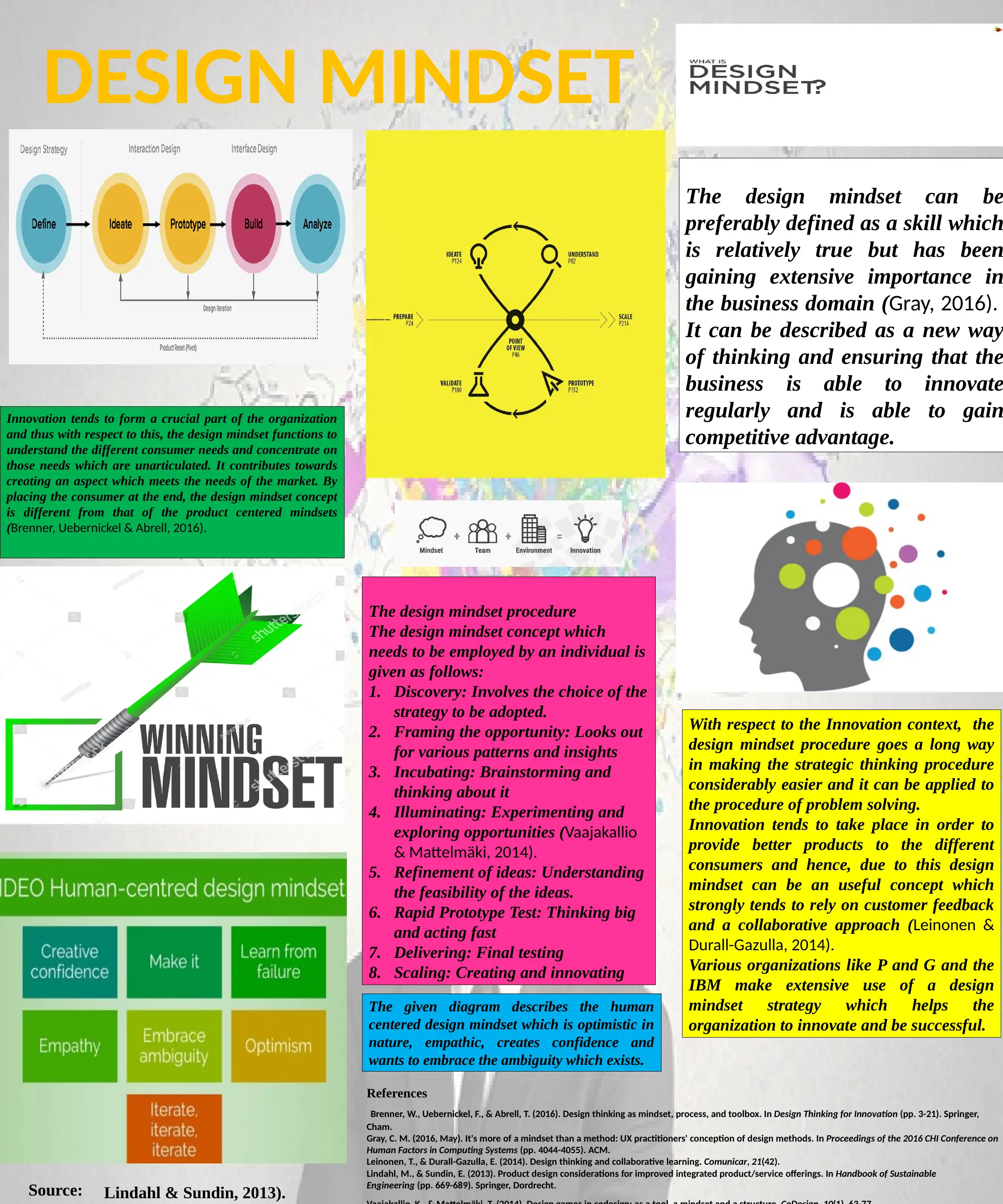MGMT20140 - Understanding the Design Mindset for Innovation
VerifiedAdded on 2023/06/10
|1
|550
|92
Essay
AI Summary
This essay defines the design mindset as a critical skill for business innovation, emphasizing its role in understanding consumer needs and fostering a competitive advantage. It contrasts the design mindset with product-centered approaches, highlighting its focus on the consumer. The essay outlines the design mindset procedure, includi...

The design mindset can be
preferably defined as a skill which
is relatively true but has been
gaining extensive importance in
the business domain (Gray, 2016).
It can be described as a new way
of thinking and ensuring that the
business is able to innovate
regularly and is able to gain
competitive advantage.
Innovation tends to form a crucial part of the organization
and thus with respect to this, the design mindset functions to
understand the different consumer needs and concentrate on
those needs which are unarticulated. It contributes towards
creating an aspect which meets the needs of the market. By
placing the consumer at the end, the design mindset concept
is different from that of the product centered mindsets
(Brenner, Uebernickel & Abrell, 2016).
With respect to the Innovation context, the
design mindset procedure goes a long way
in making the strategic thinking procedure
considerably easier and it can be applied to
the procedure of problem solving.
Innovation tends to take place in order to
provide better products to the different
consumers and hence, due to this design
mindset can be an useful concept which
strongly tends to rely on customer feedback
and a collaborative approach (Leinonen &
Durall-Gazulla, 2014).
Various organizations like P and G and the
IBM make extensive use of a design
mindset strategy which helps the
organization to innovate and be successful.
The design mindset procedure
The design mindset concept which
needs to be employed by an individual is
given as follows:
1. Discovery: Involves the choice of the
strategy to be adopted.
2. Framing the opportunity: Looks out
for various patterns and insights
3. Incubating: Brainstorming and
thinking about it
4. Illuminating: Experimenting and
exploring opportunities (Vaajakallio
& Mattelmäki, 2014).
5. Refinement of ideas: Understanding
the feasibility of the ideas.
6. Rapid Prototype Test: Thinking big
and acting fast
7. Delivering: Final testing
8. Scaling: Creating and innovating
References
Brenner, W., Uebernickel, F., & Abrell, T. (2016). Design thinking as mindset, process, and toolbox. In Design Thinking for Innovation (pp. 3-21). Springer,
Cham.
Gray, C. M. (2016, May). It's more of a mindset than a method: UX practitioners' conception of design methods. In Proceedings of the 2016 CHI Conference on
Human Factors in Computing Systems (pp. 4044-4055). ACM.
Leinonen, T., & Durall-Gazulla, E. (2014). Design thinking and collaborative learning. Comunicar, 21(42).
Lindahl, M., & Sundin, E. (2013). Product design considerations for improved integrated product/service offerings. In Handbook of Sustainable
Engineering (pp. 669-689). Springer, Dordrecht.
DESIGN MINDSET
The given diagram describes the human
centered design mindset which is optimistic in
nature, empathic, creates confidence and
wants to embrace the ambiguity which exists.
Source: Lindahl & Sundin, 2013).
preferably defined as a skill which
is relatively true but has been
gaining extensive importance in
the business domain (Gray, 2016).
It can be described as a new way
of thinking and ensuring that the
business is able to innovate
regularly and is able to gain
competitive advantage.
Innovation tends to form a crucial part of the organization
and thus with respect to this, the design mindset functions to
understand the different consumer needs and concentrate on
those needs which are unarticulated. It contributes towards
creating an aspect which meets the needs of the market. By
placing the consumer at the end, the design mindset concept
is different from that of the product centered mindsets
(Brenner, Uebernickel & Abrell, 2016).
With respect to the Innovation context, the
design mindset procedure goes a long way
in making the strategic thinking procedure
considerably easier and it can be applied to
the procedure of problem solving.
Innovation tends to take place in order to
provide better products to the different
consumers and hence, due to this design
mindset can be an useful concept which
strongly tends to rely on customer feedback
and a collaborative approach (Leinonen &
Durall-Gazulla, 2014).
Various organizations like P and G and the
IBM make extensive use of a design
mindset strategy which helps the
organization to innovate and be successful.
The design mindset procedure
The design mindset concept which
needs to be employed by an individual is
given as follows:
1. Discovery: Involves the choice of the
strategy to be adopted.
2. Framing the opportunity: Looks out
for various patterns and insights
3. Incubating: Brainstorming and
thinking about it
4. Illuminating: Experimenting and
exploring opportunities (Vaajakallio
& Mattelmäki, 2014).
5. Refinement of ideas: Understanding
the feasibility of the ideas.
6. Rapid Prototype Test: Thinking big
and acting fast
7. Delivering: Final testing
8. Scaling: Creating and innovating
References
Brenner, W., Uebernickel, F., & Abrell, T. (2016). Design thinking as mindset, process, and toolbox. In Design Thinking for Innovation (pp. 3-21). Springer,
Cham.
Gray, C. M. (2016, May). It's more of a mindset than a method: UX practitioners' conception of design methods. In Proceedings of the 2016 CHI Conference on
Human Factors in Computing Systems (pp. 4044-4055). ACM.
Leinonen, T., & Durall-Gazulla, E. (2014). Design thinking and collaborative learning. Comunicar, 21(42).
Lindahl, M., & Sundin, E. (2013). Product design considerations for improved integrated product/service offerings. In Handbook of Sustainable
Engineering (pp. 669-689). Springer, Dordrecht.
DESIGN MINDSET
The given diagram describes the human
centered design mindset which is optimistic in
nature, empathic, creates confidence and
wants to embrace the ambiguity which exists.
Source: Lindahl & Sundin, 2013).
Paraphrase This Document
Need a fresh take? Get an instant paraphrase of this document with our AI Paraphraser
1 out of 1
Related Documents
Your All-in-One AI-Powered Toolkit for Academic Success.
+13062052269
info@desklib.com
Available 24*7 on WhatsApp / Email
![[object Object]](/_next/static/media/star-bottom.7253800d.svg)
Unlock your academic potential
© 2024 | Zucol Services PVT LTD | All rights reserved.




